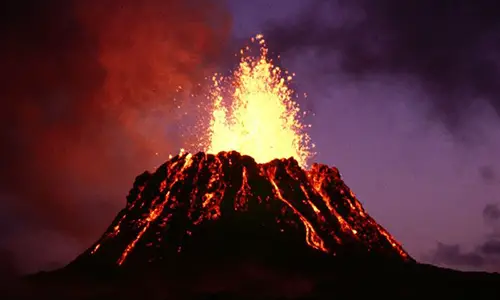1. An Active Volcano
Kilauea Volcano started to form 300,000-600,000 years ago, and it has been active ever since. Mount Kilauea appeared from the sea 50,000-100,000 years ago. In 1790, a powerful explosion killed at least 80 people mostly Hawaiian warriors and their families, when they were overwhelmed by an extremely fast flow of gas and ash. A 1959 eruption produced some of Kilauea’s spectacular lava fountains of the 20th century. The most current eruption began on January 3, 1983, and is continuing.
2. Youngest volcano
Kilauea is the youngest volcano found on the Big Island of Hawaii, on the southeastern slope of Mauna Loa in Hawaii Volcanoes National Park. The volcano formed over a hot spot under the crust. Other volcanoes on the Big Island include Mauna Kea, Mauna Loa, and Hualalai.
3. Kilauea size
Kilauea is located in a crater that is 3,646 ft (1,111 m) deep and has a circumference of 8 miles (13km). An enclosure of volcanic rock (200 to 500) ft high surrounds Kilauea. Kilauea rises 4,190 feet above sea level and covers about 14 percent of the land area of the Big Island. The whole area of the volcano is 552 square meters.
4. Home for the fire goddess
The summit caldera holds a lava lake known as Halema`uma`u that is believed to be the home of the Hawaiian volcano goddess, Pele. Hawaiian chants and oral traditions tell in an indirect form the many eruptions fomented by an angry Pele.
5. Kilauea Eruptions
Kilauea has had 61 taken down eruptions in the recent cycle as stated by the U.S. Geological Survey. The volcano has been erupting on a continuous basis since 1983. For the previous few years, lava from Puu Oo crater mainly streamed south in the direction of the ocean. On June 2014, lava erupted from a vent on the northeast flank of the crater. The new lava headed northeast into rugged ground crumpled by deep cracks and depressions and then vanished underground a few weeks later. In September, lava welled up out of the cracks and resurfaced again, less than a mile from the closest homes in Kaohe Homesteads.
6. Beliefs about Kilauea
Kilauea was initially believed to be a satellite of Mauna Loa instead of a separate volcano. Research conducted during the last decades however indicate that not only is Kilauea a distinct volcano, but it is a magma-plumbing system that goes over 60 kilometers deep into the Earth.
7. Kilauea tourism
The first hotels came into sight around the edge of the Kilauea Volcano in the 1840s. The region became a National Park in 1916 and tourism continued to grow greatly. Today around 2.6 million tourists visit the volcano and surrounding areas each year mainly due to its location in beautiful Hawaii coupled with its active yet docile nature.
8. The name Kilauea
The word Kilauea connotes “spewing” or “much spreading” in Hawaiian. Kilauea is Hawaii’s most active volcano. Kilauea is also nicknamed “Drive-in” volcano due to the relative safety and ease of approach.
9. The first president to visit Kilauea
In July of 1934, President Roosevelt visited Hawaii making him the first acting president to visit the island. Throughout his stay, he visited the crater of Kilauea. In honor of the Hawaiian legend, he offered a bunch of Ohelo berries to Pele, the goddess of fire.
10. Kilauea is a shield volcano
Kilauea is a shield volcano, which means that it is a volcano with broad, gentle slopes and assembled by the explosion of fluid basalt lava, which means lava flows of low viscosity. Lava runs out of the volcano in all directions from a middle summit vent or set of vent creating a broad, gently sloping cone of flat, domical form.











Leave a Reply